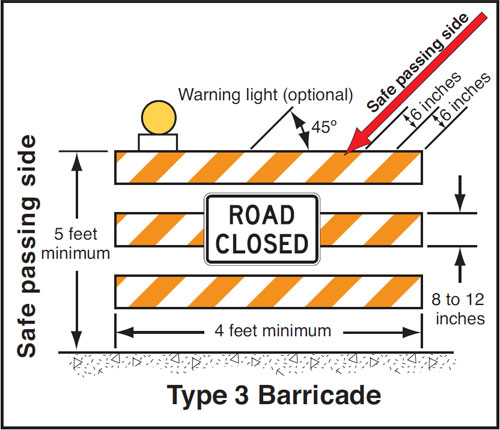Traffic Control Devices
Traffic control devices are signs, signals, markings, and other devices used to regulate, warn, or guide road users. These devices are placed on or adjacent to a road by authority of the agency having jurisdiction over the road.
Regulatory Signs
- Inform persons using the road of traffic laws, regulations, and legal requirements.
- Are enforced by law as authorized by the agency with jurisdiction over the road.
 |
 |
 |
 |
Warning Signs
- Warn road users of unexpected conditions or situations on or adjacent to a road.
- Indicate the need for caution by road users.
- May call for reduced speed or an unexpected maneuver.
- Are diamond shaped.
- Must be retroreflective fluorescent pink or orange.
 |
 |
 |
 |
Guide Signs
- Inform road users of important sites such as incident bases, helibases, and staging areas.
- Allow time for road users to make appropriate decisions before reaching an intersection.
- Are rectangular shaped.
 |
 |
 |
Typical Barricade Installations
Use Type 3 barricades (three rails) to close or partially close roads for temporary traffic control activities related to incident management. See pages 22 and 23 for proper barricade installation for road closures.
Use Type 1 (one rail) and Type 2 (two rails) barricades where traffic flow is maintained through the temporary traffic control zone. Minimum length is 24 inches.
Stripes on barricade rails shall be alternating 6-inch orange and white retroreflective stripes. Stripes on the rails shall point downward in the direction that road users are to pass. If traffic is not allowed past the closure, stripes shall point downward to the center of the barricade.

Standard traffic control signs are often needed on Type 3 barricades. Typical signs mounted on these barricades include: ROAD CLOSED, AREA CLOSED, or ROAD USE PERMIT REQUIRED FOR THRU TRAFFIC.
Do not place other signs, posters, or maps on barricades.
Mount signs on the barricade at least 1 foot above the road. Signs mounted on Type 3 barricades
should not cover more than 50 percent of the top two rails or 33 percent of the total
area of the three rails.
Barricades shall be visible from both directions when incident and permitted local traffic exit the area from the other direction.

A barricade is placed in the lane where traffic will stop.
Stripes point to the direction that traffic will pass.
(Click here for long description)
Use only crashworthy barricades.
Anchor barricades that may overturn in the wind with appropriate ballast, such as sandbags or water jugs.
Do not place ballast on top of any striped rail. Do not use objects for ballast on a barricade that will not deform in a collision. Examples of incorrect objects are rocks and concrete blocks.
Homemade barriers, such as sawhorses and wooden posts, do not meet the required standards.

